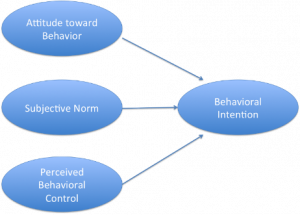87 Theory of Planned Behavior
Theory of Planned Behavior
What is the Theory of Planned Behavior?
The Theory of Planned Behavior (TPB) predicts an individual’s intention to engage in a behavior at a specific time and place. It posits that individual behavior is driven by behavior intentions, where behavior intentions are a function of three determinants: an individual’s attitude toward behavior, subjective norms, and perceived behavioral control (Ajzen, 1991).
Key Concepts and Dimensions
Behavioral Intention
This is a proxy measure for behavior. It represents a person’s motivation in the sense of her or his conscious plan or decision to perform certain behavior (Conner & Armitage, 1998). Generally, the strong the intention is, the more likely the behavior will be performed.
Attitude toward Behavior
This refers to the degree to which a person has positive or negative feelings about the behavior of interest. It entails a consideration of the outcomes of performing the behavior.
Subjective Norm
This refers to the belief about whether significant others think he or she will perform the behavior. It relates to a person’s perception of the social environment surrounding the behavior.
Perceived Behavioral Control
This refers to the individual’s perception of the extent to which performance of the behavior is easy or difficult (Ajzen, 1991). It increases when individuals perceive they have more resources and confidence (Ajzen, 1985; Hartwick & Barki, 1994; Lee & Kozar, 2005)

Measurements
Developing a measure utilizing the Theory of Planned Behavior is highly dependent upon the topic being considered. Measures should assess all main components of the theory: attitude toward behavior, subjective norms, perceived behavioral control, and intention. Typical measures follow a Likert-style format and can range in length from a few succinct questions to much longer and more comprehensive surveys.
The article below describes how to construct a TPB questionnaire:
- Ajzen, I. Constructing a theory of planned behavior questionnaire. Retrieved from:http://people.umass.edu/~aizen/pdf/tpb.measurement.pdf
Two specific examples of the TPB questionnaire are presented below:
- In their study, Davis et. al. (2002) developed a questionnaire to predict high-school completion among African Americans. This instrument assessed major constructs of TPB, as well as several sections dealing with such issues as general and racial self-esteem, academic self-efficacy, neighborhood living conditions, and after-school activities.
- The second paper described a conceptual model, based on the TPB, which explained how college students’ beliefs influence their intention to adopt mobile devices in their coursework. The questionnaire used in this research contained 30 items and measured the participants’ perceptions with a 7-point Likert scale. The questionnaire can be found in Appendix A of the paper (Cheon et. al., 2012).
References
Ajzen, I. (1985). From intentions to action: a theory of planned behavior. In J. Huhl, & J. Beckman (Eds.), Will; performance; control (psychology); motivation (psychology) (pp. 11–39). Berlin and New York: Springer-Verlag.
Ajzen, I. (1991). The theory of planned behavior. Organizational Behavior and Human Decision Processes, 50(2), 179-211.
Cheon, J., Lee, S., Crooks, S. M., & Song, J. (2012). An investigation of mobile learning readiness in higher education based on the theory of planned behavior. Computers & Education, 59(3), 1054-1064. doi:http://dx.doi.org/10.1016/j.compedu.2012.04.015
Conner, M., & Armitage, C. J. (1998). Extending the theory of planned behavior: A review and avenues for future research. Journal of Applied Social Psychology, 28(15), 1429-1464.
Davis, L., Ajzen, I., Saunders, J. & Williams, T. (2002). The Decision of African American Students to Complete High School: An Application of the Theory of Planned Behavior. Journal of Educational Psychology, 94(4), 810-819.
Hartwick, J., & Barki, H. (1994). Explaining the role of user participation in information system use. Management Science, 40(4), 440–465.
Lee, Y., & Kozar, K. (2005). Investigating factors affecting the anti-spyware system adoption. Communications of the ACM, 48(8), 72–77.

